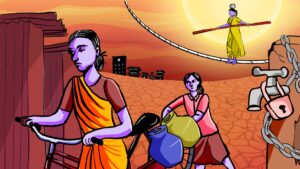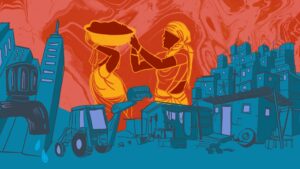In Estimating Heat-Related Income Loss, Workers Should Be Centred
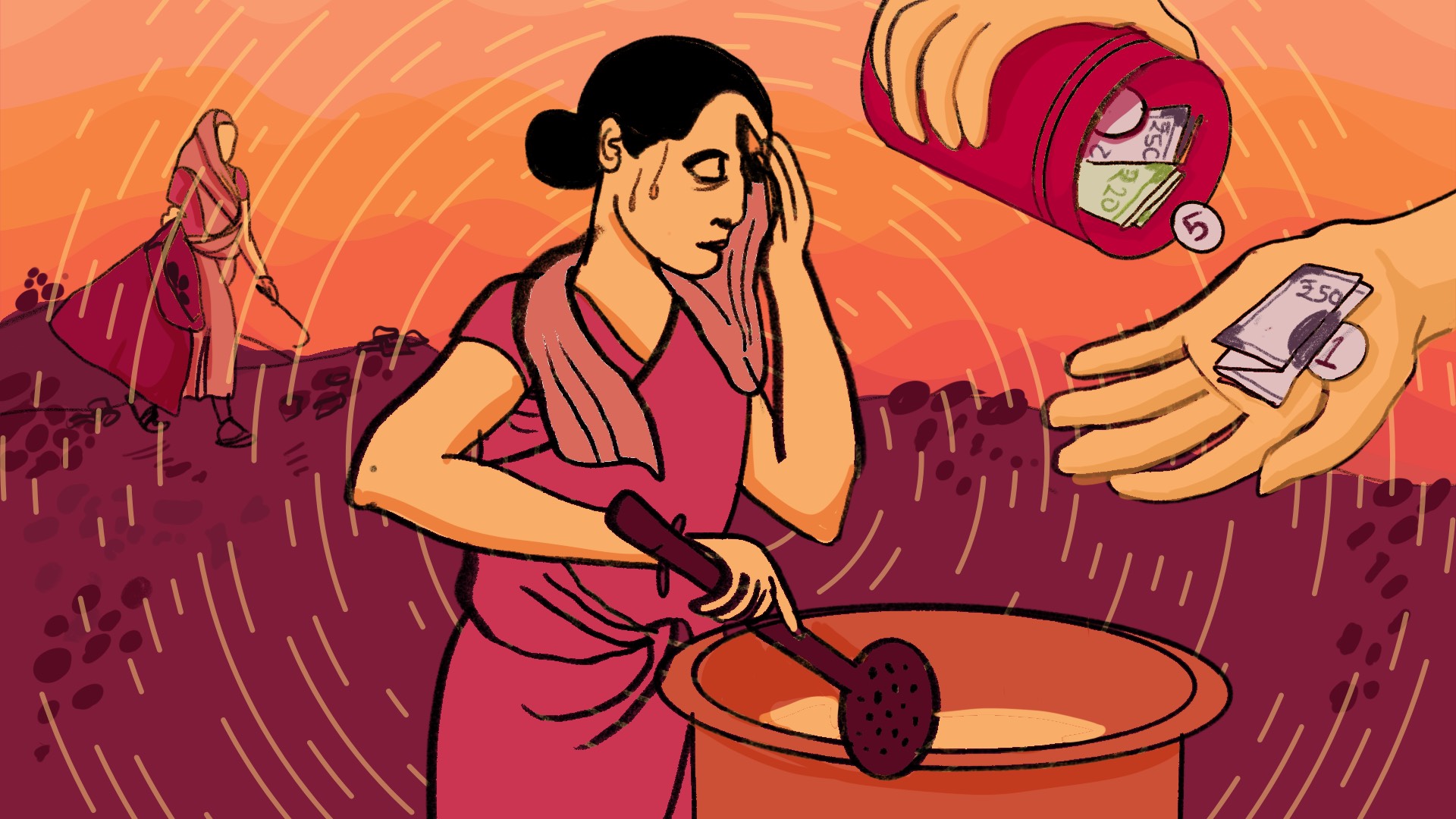
In just the first 18 days of April, Babita Malik, 40, had taken more than a week off from her job as a safai saathi (dry waste segregator) at an NGO-run waste management plant in Goa’s Harvalem village. The heat, she says, has become unbearable. Last week, Goa reported one of the highest “feels like” temperatures–after accounting for humidity–in the country
Every morning, except Sundays, Babita finishes her household work and reaches the tin-roofed centre at 9 am to segregate waste plastic and clothes till 5 pm. “We take breaks at around 10 am, 1 pm and 3:30 pm. But in the heat, it is difficult to do a lot of work,” she said. We are sitting in a part of the plant where workers rest and eat.
How does the heat impact the workers? Kashi Narayan Malik, 60, opted to enact her answer – she heaves dramatically to show breathlessness and the 14 other workers sitting in the room burst into laughter.

Heat also brings significant loss of income. On an average month, workers at the plant earn around Rs 11,000 but in summer months, this goes down to Rs 7,000, said Babita. “When it is hot, it becomes really difficult to sleep at night. So I wake up late, leaving little time to finish my household work before I can go to work. So, I end up taking the day off.”
The workers at the centre are paid on the basis of the amount of work they put in. The segregated waste is sold to vendors and 85% of that payment is split among the workers based on the number of days they work. In an average month, the workers earn around Rs 11,000; the NGO takes 15% to pay for rent and other utilities.
The climate crisis has made extreme weather events like heat waves more frequent and intense and this extreme heat impacts the body’s ability to regulate the temperature, gravely impacting the health and productivity of workers. These impacts also create financial stress for workers by reducing their incomes and increasing their expenses.
A 2024 study of 400 low-income workers in Delhi found that every degree Celsius increase in wet bulb temperature was associated with a 13% decrease in gross income and 19% decrease in net income. (Wet bulb temperature is calculated by wrapping a thermometer in wet cloth and denotes the lowest temperature that can be reached in the current ambient conditions by just evaporation, and thus sweating, alone.)
Heat stress – a condition when the body is unable to get rid of excess heat to regulate its core temperature – impacts multiple aspects of a worker’s life. It affects the physical and mental health, children’s education, food security and nutrition and also makes women workers more vulnerable to gender-based violence, said a senior coordinator at the Self Employed Women’s Association (SEWA), a trade union of women workers from the informal sector. “The cash crunch often leads to tiffs between the workers, who are the sole breadwinners of the family and their husbands on where to spend the money. There was also an increased incidence of substance abuse among children because in order to curb hunger, they didn’t have any option but to chew on tobacco,” she said.
.But, most of the existing research fails to address the complex nature of this financial stress and instead focuses on the larger financial impact on the economy. Estimates suggest women are losing 19% of their paid working hours due to heat, which costs the Indian economy 0.8% of the GDP or around USD67 billion annually. Accounting for unpaid work, which takes up 71% of Indian women’s time, leads to a 260% increase in heat-related productivity losses, found this report on India, Nigeria and the United States.
A 2021 systematic review of studies on such productivity loss found that large economic losses occurred mainly in South and Southeast Asia, Sub-Saharan Africa, and Central America.
A worker-centric evidence system and ensuring basic labour rights like fair wages, access to toilets, drinking water and protective equipment is crucial for workers to deal with these impacts, said the women workers and researchers that we spoke to.
Income Loss, Increased Expenses
The March of 2022 was the hottest-ever to be recorded since 1901 when the authorities began collecting data. That year, 90% of the women working in the informal sector reported an income loss of 30-50% depending on what trade they belonged to, as per an estimate by the SEWA coordinator.
And this dip is more pronounced for women-headed households. A 2024 Food and Agriculture Organization (FAO) study of data from 24 countries including India found that female-headed households lose 8% more of their income due to heat stress than male-headed households. It also found that just a 1°C increase in average temperatures could mean a 34% greater income loss for women than men.
The study also found that if climate change is not addressed, this gap between wages will continue to widen, especially because of the existing difference in agricultural productivity and wages for men and women.
For home-based workers, textile workers or even ASHA workers, productivity and income are directly connected because they engage in daily wage labour, said Apekshita Varshney, founder of HeatWatch, an initiative aimed at expanding awareness and action around the impact of extreme heat. “In these cases, how much work one is able to do every day is directly how much they get paid. And on top of that, there might be penalisation if they are not meeting certain targets.”
A key example of that are garment workers, who face the brunt of the high targets and tight deadlines that brands force on suppliers. Last year, an HR manager at a garment factory told Behanbox that they force workers to work even in temperatures as high as 40ºC, despite the maximum permitted temperature being 30ºC. “I know that it is very difficult to work in these conditions, but we have orders which we have to deliver on time – or else we will run into a loss, and won’t be able to pay the workers,” said the official.
ASHA workers also face a similar situation, said Apekshita. While their incentives are based on the number of beneficiaries they help, they have set targets under each scheme and initiative that they have to fulfill.
Extreme Health Impacts
The financial impact of heat is linked to its health impacts. When a person is exposed to heat, their core body temperature rises and to offset this, the body releases sweat. A rapid rise in heat gain impacts the body’s ability to regulate temperature, increases risk for heat exhaustion and heatstroke, stresses the heart and kidneys, worsens chronic conditions and could even lead to death.
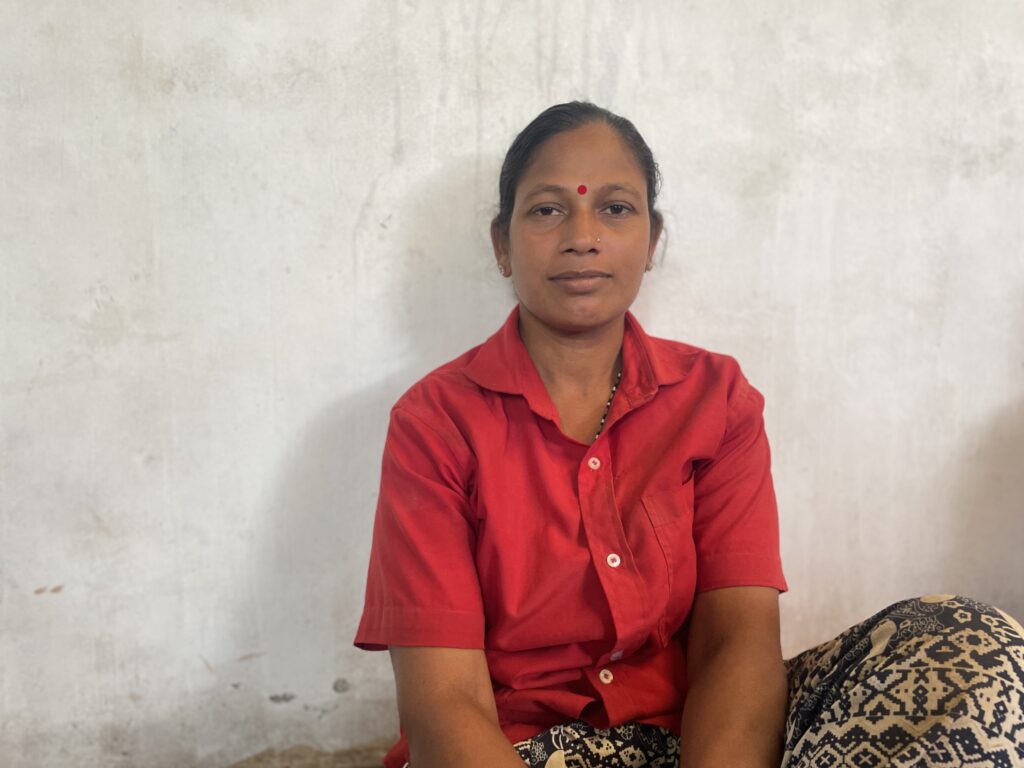
As Babita Malik’s experience indicated, it is not just about the heat at the workplace but also at home. “If one is not able to sleep in the most comfortable cool conditions, the entire sleep cycle gets disrupted. So they are not sleeping well, eating well or hydrating well. All this has a significant impact on health. And if they do not have paid leave, whatever workdays they miss has a direct impact on their income,” said Apekshita.
An ASHA worker in Kalaburagi, one of the hottest districts in Karnataka, told researchers from Indian Institute for Human Settlements that her blood pressure had dropped because she had to walk around in the heat. “I aim to wrap up work by 3-4 pm and hence I don’t eat lunch on time,” she said. She had to be injected with iron supplements at the primary healthcare centre to settle her blood pressure.
Researchers, Swati Surampally and Divyanshi Vyas from the Institute’s School of Environment and Sustainability, shared these insights from their ongoing project titled, ‘Spatialising Climate Impacts on Health: A Focus on Vulnerable Settlements in Megacities of the Global South’.
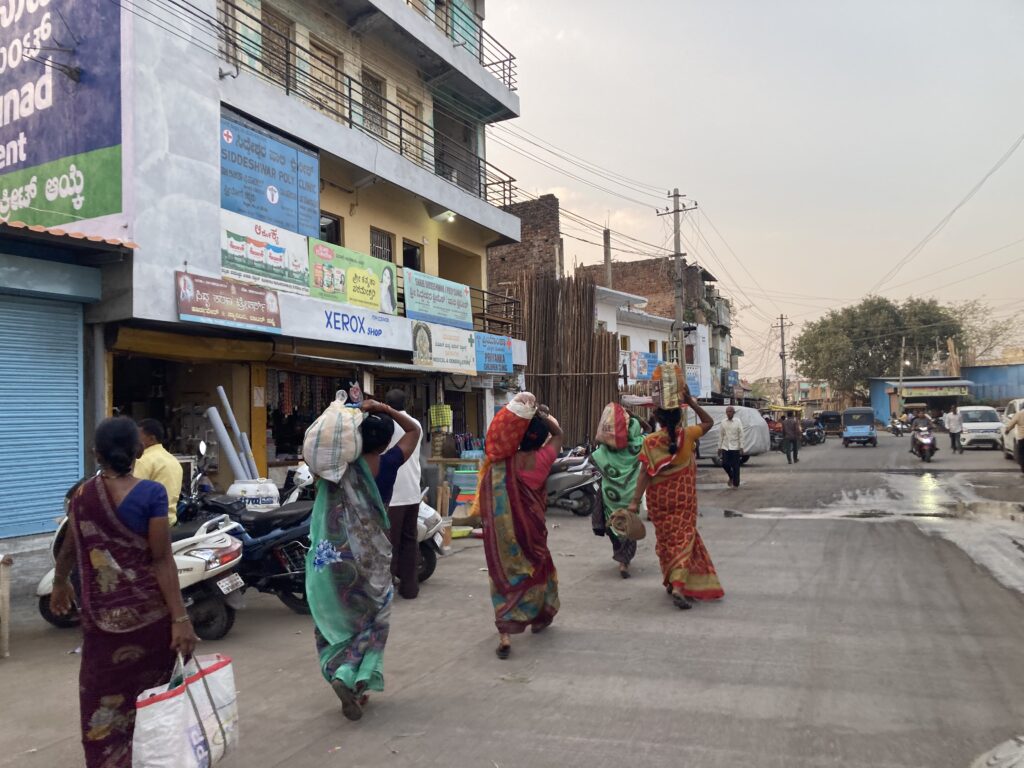
A 40-year-old self help group worker the researchers interviewed said that because her work was to make rotis, she had to sit by a firewood stove that burns continuously and this increases her exposure to radiant heat. This brought on a burning sensation while urinating, she reported, which her doctor had told her was caused by the heat.
Brick kiln workers, mid-day meal workers and domestic workers also face similar radiant heat from kilns and cooking fuel. A study involving 40 informal workers in Delhi found that domestic workers are often forced to spend hours in hot kitchens, cooking over gas stoves, often with fans switched off. They are rarely allowed rest or access to cooling, and breaks are often denied, even when they feel dizzy or dehydrated.
“Sometimes, it is not even about specific illnesses. A lot of times people tell us that they are just exhausted and that they have no energy. That they are not able to work at the same pace, which often employers don’t understand and they force workers to work at the same speed and pace,” said Apekshita.
There is also the question of increased health expenditure adding to the financial stress on workers. In India, half of the total medical expenditure is out of people’s pockets. Last August, we had reported how the underfunded, understaffed and overstressed public healthcare system leaves people with no option but to rely on private healthcare providers or quacks.
Unseen Costs
High summers bring on additional costs of living. In Goa’s Socorro village, Shamshad Shaikh, 26, a domestic worker said that she faces financial difficulties in keeping her family cool and comfortable in summers.
In the last month, Shamshad, her husband and two children (a 12-year-old and a year-and-a-half old) have been sleeping with three fans on. “Our house has a tin roof. So no matter what we do, it still feels very hot inside. I have been thinking about buying a cooler but it will cost at least Rs 8-9,000. I cannot afford it so I have parked that thought for now,” she said.
But the fan usage has added to her electricity bill. In February, her bill was around Rs 300 which shot up to Rs 1,000, she said, adding that luckily her agreement with the landlord is that she will pay the electricity bill.
She, however, finds it hard to save any of her earnings in summers. “Of the Rs 12,000 that I earn every month, I usually manage to save at least Rs 1-2,000. But in summer months that is impossible. My son keeps asking me for cold drinks and ice creams and I end up spending at least Rs 1,000 just on that,” she said.
In Harvalem, the workers pool in money every 2-3 days and ask the centre manager to go buy cold drinks for them. In her house, Babita had to recently spend on a new fan because the old fan had stopped working.
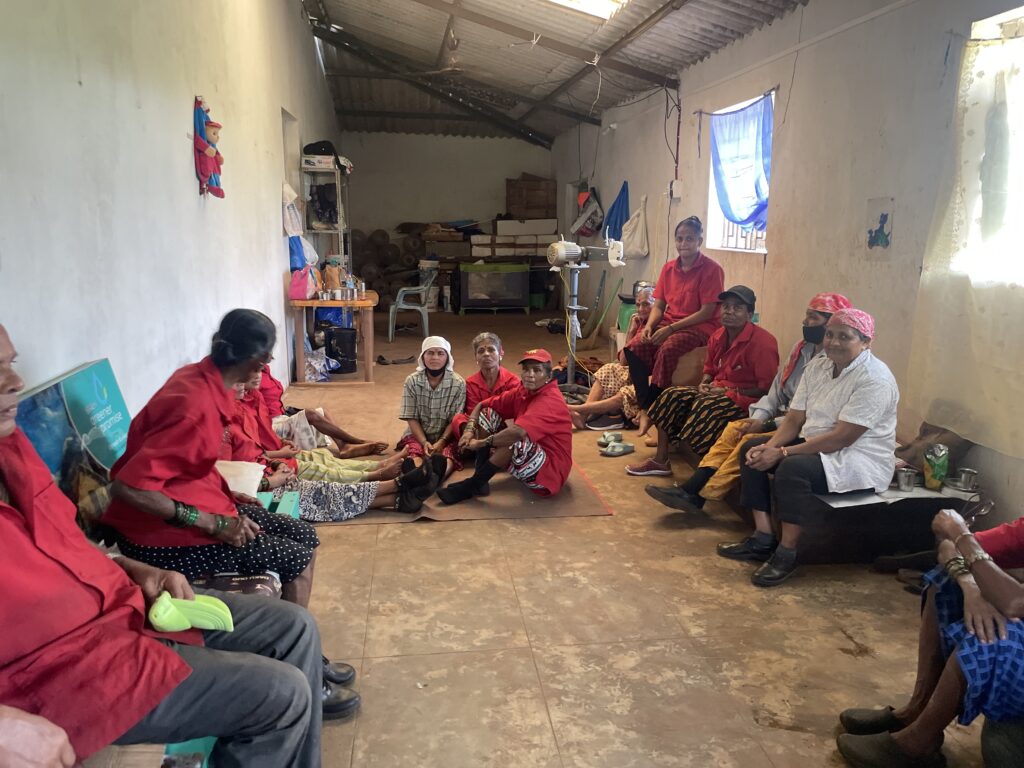
“In low-income settlements in urban areas, many people have to buy water. And we have heard from the people that a family that needed one 20-litre bottle for 3-4 days, has to buy two bottles because the need to drink water has gone up,” said Apekshita.
A street vendor in Delhi whom we interviewed also said that she is spending more on water. Now, each day, she buys at least 2-3 bottles of water, each costing Rs 20. She also said that she has got urinary tract infections and that each visit to the doctor costs her Rs 200, with an additional expense of Rs 600-700 on medicines.
Centring Workers
Despite years of studying the loss of productivity due to heat, researchers are struggling to build evidence. A big reason for that is how economists define productivity loss.
A 2021 systematic review of 30 studies published between 1990 and 2020 on heat-related productivity categorised four different approaches based on the methodologies. The most popular one was the human capital method which looked at working hours or days lost and multiplied that by a unit wage value. Another one explored the relationship between heat index and output. And the remaining two combined various factors to address direct and indirect impacts of heat, by accounting for interdependent sectors.
But what is common among them all is that they focus only on how heat impacts the economy and its outputs. And this economic approach does not have the space to document the complex nature of impact on workers. This gap impedes policies that target worker well-being by providing adequate social security protection. Despite understanding the severe impacts of extreme heat, the National Disaster Management Authority is yet to declare heatwaves as a natural disaster. Doing so would help state governments access funds under the National Disaster Relief Fund to provide relief and compensation, in case the State Disaster Relief Fund falls short.
Vidhya Venugopal is a professor and country director of the Global Health Research Centre for Non Communicable Diseases and Environmental Change funded by the UK’s National Institute of Health and Care Research (NIHR) at the Sri Ramachandra Institute of Higher Education & Research (SRIHER). She has conducted studies on the impact of heat on different kinds of workers, including agricultural workers, salt pan workers and cashew workers. According to her, collating productivity loss data as economists require is incredibly difficult, especially in the informal sector, because there are no set work targets and quantitative measurements are challenging.
She used the example of a woman working in a small or medium enterprise where her target for the day is to make 100 kg of a snack mixture per day for a payment of Rs 800 per day. Vidhya said, “If she cannot complete the target of 100 kg due to heat fatigue and get paid less for the day, then you can call it a wage loss. If she extends her shift to 13 hours instead of the usual 8 to meet her daily target, is it accurate to say she experiences a financial loss? While we could calculate how much less she earns per hour by dividing her salary by 13, that’s not the correct way to assess the situation. Even though she’s at the company for four extra hours, these hours are unpaid as overtime. Therefore, it’s inaccurate to claim she suffers a financial loss in this context.”
When asked if this extra time spent can be used as a proxy for income loss, Vidhya said, “That is what we have done, but economists are not happy about it. For a common person, the logic is very straightforward. If you are working four extra hours for the same amount of work, then you are experiencing an economic loss; however, that is not how economics operates.”
She said that there is an approach to research that centres workers, but it is very difficult to get published. “I have detailed data on 180 women workers, but it is qualitative data. It is okay for a documentary but not for publishing. Quantitative data is what economists ask for,” she said.
And collating this data is particularly difficult because issues are industry-specific and location-specific. A salt pan worker, she pointed out, will have different workplace hazards and wage issues from a snack unit worker. “It is difficult to collect productivity data unless it is in the formal sector,” she said.
Avinash Chanchal, deputy programme director of campaigns at Greenpeace South Asia, points to the importance of seeing workers only in terms of their economic productivity. “Workers are facing different kinds of impacts due to heat from sociological to cultural,” he said.
Care Work Excluded
Many days Shamshad said she has no energy to cook after working all day. “Yesterday I could not bring myself to cook anything. The heat had given me a migraine. So I gave my son some milk and cornflakes and slept. Around 11:30 pm I woke up because I was hungry. I made some khichdi, ate it and tried to sleep. But it was so hot that I could not,” she said.
When she was unable to sleep till 3 am, she took a painkiller and slept. The next morning, she said she had trouble staying awake and focusing on work despite several cups of tea.
Women in India spend around 6 hours on unpaid work, of which one hour is a direct result of extreme heat, found this report by Atlantic Council’s Climate Resilience Center. Calculating for this productivity-loss. It also estimates that by 2050, the time women will have to spend on unpaid work will increase to 8.3 hours a day if no action is taken to reduce emissions or adapt to the heat.
“I don’t know of any studies that assess this directly in India but anecdotally, we find that unpaid care work like fetching water and cooking is tougher during heatwaves or under extreme temperatures. Women are waking up earlier to avoid working during very hot hours. This has a ripple effect on ability to do paid work,” said Chandni Singh, who leads the School of Environment & Sustainability at IIHS.
Babita said when it is hot, it takes her 30 minutes extra to collect firewood for cooking. “Every week, I walk around half an hour to collect firewood but when it is hot, I go earlier in the morning. But I still take longer and I get more tired,” she said.
One key adaptation technique that workers adopt is pausing work when it is hot and resuming it in the evening, said Vidhya. “So they spend longer time at workplaces than they should. And when they travel home later, they might resort to using more expensive modes of transportation for safety reasons. They might also end up buying food because they are too worn out to go home and prepare a meal, which amounts to an additional expense for the worker,” she added.
How Can Policies Tackle This Issue?
While evidence on the financial impact of extreme weather events is evolving, a solution that has become popular is parametric insurance. Unlike regular insurance where a person who has faced a loss has to file a claim, in parametric insurance, the person receives a pre-set amount whenever a weather-related threshold is met.
Depending on the kind of extreme weather event that the insurance is targetting, this threshold can be a specific temperature limit or wind speed or amount of rainfall.
In 2023, SEWA introduced an extreme heat micro-insurance programme for 21,000 of its members in five districts of Gujarat. Last year, it was scaled up to cover 50,000 members across 23 districts in Gujarat, Rajasthan and Maharashtra. The project has set trigger temperatures for each district, decided based on satellite data from the last 40 years.
When the temperature crosses the trigger temperature for a set number of consecutive days, an automatic payment gets released into the bank accounts of the workers. In 2023, there was no payout but in 2024, workers in 17 districts got an average of around Rs 900 with the lowest payment being Rs 152 and highest at Rs 1,100.
There are some issues with this approach. For one, it is the employers who are setting the parameters and offering the payout, and they have the financial incentive to keep the amount low and the heat threshold high.
Another problem SEWA faced is that the data that they use to determine the trigger temperature are not localised. “For example, I am sitting near the Ellis bridge in Ahmedabad but the satellite data is specifically based on the temperature at a central latitude and longitude in the district. So, feels-like temperature and actual temperature are different,” said their coordinator.
Vidhya said that parametric insurance might help women workers, as it gives them a choice to not work on a day when the heat is extreme, while still being paid. But she also stressed the need for gender-sensitive policies and said that heat should be included in the Employee State Insurance Scheme (ESIS) that provides occupational health insurance.
Beena Pallical, the general secretary of the National Campaign on Dalit Human Rights, also stressed on the need for some form of heat insurance. Highlighting how out-of-pocket expenses deter workers from seeking healthcare services, she said: “If there is some small insurance given to them, either a health insurance, social security, or some extra amount that is paid every month, they will be able to go to hospital in case of medical conditions and take care of their bodies and health.”
But the issues are more fundamental, said Apekshita. “The demand from many workers groups has so far not been a top up but fair wages, access to toilets, water and cooler workspaces,” she said.
Bhuvaneshwari Kumar, an Anganwadi worker and union leader from Bihar’s Begusarai, also underscored the need for adequate infrastructure. “The Anganwadi centres need to have working fans. And then after the centre shuts at 11:30 am, we have to go out in the heat and do our field work. But we are not provided with anything – umbrellas, access to drinking water, ORS – so that we can stay healthy and do our work,” she said.
In August 2024, we had reported how basic needs like umbrellas and rain footwear are a luxury for working class women in cities like Mumbai.
Vidhya stressed the need for accessible toilets. “When there are no toilets, women workers choose to drink less water in the heat or hold on for a longer time until they find a discreet spot, which puts stress on their kidneys. This phenomenon impacts women workers more because men can relieve themselves anywhere,” she said.
“Improving access to healthcare for women, stronger support for pregnant and lactating women is key but so is reforming labour laws so that employers provide healthcare at worksites and updating Occupational Safety and Health guidelines,” said Chandni. And to do this, there needs to be legal mandates, not temporary heat action plans that currently do not hold employers accountable, she added.
But any scheme has to be designed keeping in mind the informal nature of the workforce in India, said Apekshita. Using the example of maternity benefits, she illustrated, “There are schemes available, like the Building and Other Construction Workers (Regulation of Employment and Conditions of Service) Act, 1996 (BOCW Act), to access maternity care. But so much of that is linked with formalisation of work. One has to have identity cards to be able to access these schemes. While a scheme for heat might be important, it has to be designed and implemented in a way that it reaches workers that are most impacted and vulnerable.”
We believe everyone deserves equal access to accurate news. Support from our readers enables us to keep our journalism open and free for everyone, all over the world.

